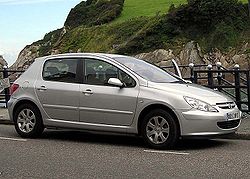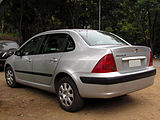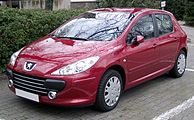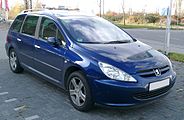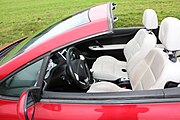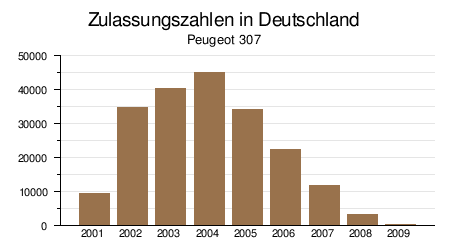Peugeot 307
| Peugeot | |
|---|---|
|
Peugeot 307 five-door (2001-2005)
|
|
| 307 | |
| Production period: | 2001-2009 |
| Class : | Compact class |
| Body versions : | Hatchback , sedan , station wagon , convertible |
| Engines: |
Otto engines : 1.4–2.0 liters (55–130 kW) Diesel engines : 1.4–2.0 liters (50–100 kW) |
| Length: | 4202-4432 mm |
| Width: | 1730-1759 mm |
| Height: | 1417-1544 mm |
| Wheelbase : | 2608-2708 mm |
| Empty weight : | 1217-1685 kg |
| Previous model | Peugeot 306 |
| successor | Peugeot 308 I , Peugeot 408 |
| Other measured values | |
| CO 2 emissions: | 129-199 g / km |
| Combined fuel consumption (EC standard): | 5.0-8.4 l / 100 km |
| Stars in the Euro NCAP - Crash Test |
|
The Peugeot 307 is a passenger car model from the French car manufacturer Peugeot . The car belonging to the compact class was launched on the market in October 2001. He also received the 2002 Car of the Year award .
history
Similar to the predecessor 306 was the variety of body styles. Initially, only the three- and five-door hatchbacks were available. In June 2002 the combination versions Break and SW were added. In August 2003 the 307 Coupé-Cabriolet (CC for short) with a foldable steel roof completed the range.
Depending on the version, the 307 was available with various petrol and diesel engines. From April 2004, a 1.6-liter HDi diesel engine with 80 kW (109 PS) and a soot particle filter was available that met the Euro 4 standard. With the standard five-speed manual transmission, the three- / five-door sedan reaches 100 km / h in 11.2 seconds and a top speed of 188 km / h. The flagship of the series is the 307 Cabriolet Coupé with an electrohydraulically retractable steel roof, which was available with three petrol engines from 1.6 to 2.0 liters as well as a 2.0-liter HDi engine.
Facelift
In May 2005, the 307 was a facelift given. It included a modified front section and new rear lights. After the facelift, the hatchback was available in six different equipment variants: "Filou", "Grand Filou Cool", "Tendance", "Prémium", "Sport" and the best and therefore most expensive equipment "Platinum".
In April 2006, two special models of the 307 were offered: "Oxygo" and "Épok". Two further special models came on the market in November 2006 (“RC-Line”) and April 2007 (“Business Line”) and were only intended for the 307 SW.
Body styles
The 307 was sold in a total of six different versions:
- Hatchback with three doors
- Hatchback with five doors
- Notchback with four doors (from 2003; only in China and South America)
- Kombi (Break) with five doors and five seats
- Kombi (SW) with five doors, seven seats and a glass roof
- Coupé-Cabriolet with two doors, four seats and a retractable steel hood
Technical specifications
Petrol engines
| model | Engine (type) | Cubic capacity cm³ |
cylinder | Output kW (PS) at 1 / min |
Torque Nm at 1 / min |
construction time | variants |
|---|---|---|---|---|---|---|---|
| 1.4 8V | TU3JP (KFW) | 1360 | 4th | 55 (75) / 5500 | 120/3400 | 03 / 2002-02 / 2004 | Hatchback |
| 1.4 16V | ET3J4 (KFU) | 1360 | 4th | 65 (88) / 5250 | 133/3250 | 11/2003–03/2008 | Hatchback, station wagon |
| 1.6 16V | TU5JP4 (NFU) | 1587 | 4th | 80 (109) / 5800 | 147/4000 | 08/2001–03/2008 1 | Hatchback, station wagon, convertible |
| 2.0 16V | EW10J4 (RFN) | 1997 | 4th | 100 (136) / 6000 | 190/4100 | 08/2001–03/2005 | Hatchback, station wagon, convertible |
| 2.0 16V | EW10A (RFJ) | 1997 | 4th | 103 (140) / 6000 | 200/4000 | 04/2005–03/2008 1 | Hatchback, station wagon, convertible |
| 2.0 16V | EW10J4S (RFK) | 1997 | 4th | 130 (177) / 7000 | 202/4750 | 06 / 2005-07 / 2007 1 | Hatchback, convertible |
Diesel engines
| model | Engine (type) | Cubic capacity cm³ |
cylinder | Output kW (PS) at 1 / min |
Torque Nm at 1 / min |
construction time | variants |
|---|---|---|---|---|---|---|---|
| 1.4 8V HDi | DV4TD (8HX / HZ) | 1398 | 4th | 50 (68) / 4000 | 150/1750 | 10 / 2001-02 / 2004 | Hatchback |
| 1.6 16V HDi | DV6 (A) TED4 (9HX / HV) | 1560 | 4th | 66 (90) / 4000 | 215/1750 | 04/2005–03/2008 | Hatchback, station wagon |
| 1.6 16V HDi | DV6TED4 (9HZ / HY) | 1560 | 4th | 80 (109) / 4000 | 240/1750 | 02 / 2004-03 / 2008 | Hatchback, station wagon |
| 2.0 8V HDi | DW10TD (RHY) | 1997 | 4th | 66 (90) / 4000 | 205/1900 | 08/2001–03/2005 | Hatchback, station wagon |
| 2.0 8V HDi | DW10ATED4 (RHS) | 1997 | 4th | 79 (107) / 4000 | 250/1750 | 08 / 2001-02 / 2004 | Hatchback, station wagon |
| 2.0 16V HD i * | DW10BTED4 (RHR) | 1997 | 4th | 100 (136) / 4000 | 320/2000 | 11 / 2003–03 / 2008 2 | Hatchback, station wagon, convertible |
* The red " i " in the HDi logo indicates the most powerful diesel engine in the 307.
- ↑ a b This engine was not available with a soot particle filter
- ↑ a b This engine was also available with a soot particle filter
- ↑ a b This engine was only available with a soot particle filter
| 1.4 16V | 1.6 16V | 2.0 16V | 1.4 HDi | 1.6 HDi (FAP) | 1.6 HDi FAP | 2.0 HDi FAP | |||
|---|---|---|---|---|---|---|---|---|---|
| Engine type and
Number of cylinders |
R4 petrol engine with multi-point injection |
R4 diesel engine with common rail injection |
|||||||
| Displacement | 1360 cc | 1587 cc | 1997 cc | 1398 cc | 1560 cc | 1997 cc | |||
| Max. Power (PS) at 1 / min |
55 kW (75 PS) 5500 |
65 kW (88 PS) 5250 |
80 kW (109 PS) 5800 |
100 kW (136 hp) 6000 |
103 kW (140 PS) 6000 |
50 kW (68 hp) 4000 |
66 kW (90 PS) 4000 |
80 kW (109 PS) 4000 |
100 kW (136 hp) 4000 |
| Max. Torque at 1 / min |
120 Nm 3400 |
133 Nm 3250 |
147 Nm 4000 |
190 Nm 4100 |
200 Nm 4000 |
160 Nm 2000 |
205 Nm 1900 |
245 Nm 1750 |
320 Nm 2000 |
| Gearbox, as standard | 5-speed manual transmission | 6-speed manual transmission | |||||||
| Gearbox, optional | - | 4-stage automatic | 4-stage automatic | - | - | - | - | ||
| Top speed | 167 km / h | 172 (170) km / h | 190 (182) km / h 180 km / h 1 |
205 (200) km / h 200 km / h 1 |
205 (200) km / h 196 km / h 1 |
160 km / h | 179 (174) km / h | 188 (183) km / h | 202 (198) km / h |
| Acceleration in s from 0–100 km / h |
15.6 | 12.8 (13.5) | 10.7 (11.9) 13.8 1 |
9.8 (9.8) 11.1 1 |
8.9 (9.8) 11.9 1 |
14.7 | 13.7 (13.8) | 12.0 (12.5) | 9.8 (10.8) |
| Fuel consumption (according to EEC guidelines, combined l / 100 km) |
6.7 p | 6.5 (6.7) S. | 7.4 (7.7) S 8.3 S 1 |
7.9 (8.3) S 8.6 S 1 |
7.7 (7.9) S 8.4 S 1 |
4.5 D | 5.2 (5.4) D. | 4.9 (5.0) D. | 5.4 (5.6) D. |
| Combined CO 2 emissions in g / km |
159 | 155 (159) | 174 (178) 194 1 |
188 (194) 204 1 |
187 (188) 199 1 |
120 | 138 (143) | 129 (131) | 142 (148) |
| Emission standard according to EU classification | Euro3 and D4 | Euro 4 | Euro3 and D4 | Euro 4 | Euro4 | Euro 4 | |||
Values in () for 307 Break / SW
1 with 4-speed automatic transmission, with manual shift gate
307 SW / Break (2002-2008)
The Peugeot 307 SW is a station wagon released in June 2002 with a variable space concept with up to seven individual seats and a large glass roof, while the Break is the classic station wagon variant. With the SW, the five-seater can be converted into a 5 + 2-seater if desired, because two additional seats can be ordered at an additional cost and snap into the corresponding floor brackets in the trunk. This reduces the trunk volume from 520 to 137 liters, although the third row is only sufficient for children and smaller people up to 1.60 m tall. The luggage compartment of the Break is 503 or 1675 liters with the rear bench seat folded down. In contrast to the similarly constructed 307 Break model, the 307 SW has a 1.4 m² glass roof made of heat-insulating laminated safety glass, known as a "panorama roof", which can be completely darkened by an electric sliding blind. Unlike the sedan, the Break and SW models are equipped with roof rails for attaching a roof rack.
In May 2005, the design was upgraded with a facelift that corresponded to the then new 407 series. The rear remained unchanged except for the chrome applications in the rear lights. At that time, the 307 SW was available in the following equipment variants that could be ordered: "Grand Filou Cool", "Prémium" and "Sport". Special models that can be ordered: “Oxygo” (from 2006), “Épok” (from 2006), “RC-Line” (from 2006) and “Business-Line” (from 2007).
.
307 CC (2003-2009)
The 307 CC followed in March 2003; it is a four-seater coupé-convertible with a two-part electro-hydraulically retractable metal roof that was developed by Magna Car Top Systems . The electrically operated steel roof opens in 25 s and is installed almost unchanged in the successor 308 CC. Vehicles with a similar roof design are Peugeot 206 CC (roof from Heuliez), 207 CC (Edscha) or Renault Mégane CC (Karmann). The 307 CC is slightly lower and longer than the sedan version, has a significantly flatter windshield that is pulled far back and has more sophisticated basic equipment. The retractable roof means that no roof rack can be fitted. A light carrier for a total weight of up to 30 kilograms can only be placed on the trunk lid.
The 307 CC was also given the new front in May 2005, like the sedan and the SW / Break. In 2005/2006 it could be ordered in four different equipment variants: "Filou", "Tendance", "Sport", and "JBL".
Engine versions
The Peugeot 307 CC was offered with three different petrol engines and, since July 2005, with a 2.0-liter diesel. The petrol versions have a 5-speed manual gearbox; the 136/140 hp version was optionally available with a 4-speed automatic gearbox with a manual shift gate. In contrast to the petrol models, the diesel version is equipped with a 6-speed manual transmission. The engine and transmission come from the 400 series. Cruise control (cruise control) and parking aid are available for all versions.
- 1.6 16V with 80 kW (109 PS)
- 2.0 16V with 100 kW (136 PS) until 03/2005, from 04/2005 with 103 kW (140 PS)
- 2.0 16V with 130 kW (177 PS)
- 2.0 HDi 16V FAP (Filtre à particules) soot particle filter with 100 kW (136 PS)
Technical specifications
| 1.6 16V 109 hp | 2.0 16V 136 PS / [automatic] | 2.0 16V 140 PS / [automatic] | 2.0 16V 177 hp | 2.0 HDi 16V 136 hp | |
|---|---|---|---|---|---|
| construction time | 01/2005–03/2009 | 03/2003–03/2005 | 04/2005–03/2009 | 03/2003–03/2009 | 06/2005–03/2009 |
| Acceleration, 0-100 km / h | 10.7-12.7 s | 10.3 / [12.0] s | 10.3 / [12.0] s | 9.5 s | 10.3 s |
| Top speed | 191 km / h | 207 / [204] km / h | 207 / [206] km / h | 225 km / h | 208 km / h |
| consumption | 7.6 l / 100 km | 8.2 / [8.9] l / 100 km | 8.1 / [8.4] l / 100 km | 8.8 l / 100 km | 6.0 l / 100 km |
| Empty weight kg) | 1515-1558 | 1532 / [1563] | 1543 / [1573] | 1565 | 1653-1685 |
| Total weight (kg) | 1850 | 1830 / [1870] | 1880 / [1900] | 1860 | 1950 |
| Tank volume (l) | 60 | 60 | 60 | 60 | 60 |
| Trunk volume (l) with the roof open / closed |
204/350 | 204/350 | 204/350 | 204/350 | 204/350 |
| Tires | 205/55 R16 on 6.5 × 16 ET31 | 205/50 R16 on 6.5 × 16 ET31 | 205/50 R16 on 6.5 × 16 ET31 | 205/50 R17 on 6.5 × 17 ET31 | 205/50 R16 on 6.5 × 16 ET31 |
The trunk volume varies due to the retractable roof.
suspension
Front: Independent wheel suspension of the Pseudo-MacPherson type with coil springs, integrated hydraulic vibration dampers and curve stabilizer.
Rear: independent wheel suspension with self-steering effect, torsion beam rear axle, coil springs, independent hydraulic vibration dampers and cornering stabilizer.
Explanation of some special models
Oxygo (from 2006): The special model Oxygo, which was available as three- and five-door, 307 Break and 307 SW, offered among other things a radiator grille with chrome inserts, fog lights, 16-inch alloy wheels "Équinoxe" and an "Oxygo" - Logo on the front doors. In addition, this special model offered instruments with a white background with chrome surrounds, a steering wheel rim covered with perforated leather and fabric seats in black / gray or black / red.
Épok (from 2006): The special model Épok was available as a five-door sedan, 307 SW and Coupé-Cabriolet 307 CC. It offered an RD4 audio system as standard, a radiator grille with chrome inlays, special metallic paintwork, anthracite-colored 16-inch alloy wheels, “Goyave” fabric and leather seats (the front seats are heated), separately adjustable automatic air conditioning, electric windows front and rear, aluminum door sills as well as numerous other aluminum applications in the interior. In contrast to the Oxygo special model, the Épok models could also be ordered in conjunction with a converter automatic transmission: the two-liter gasoline engine with a four-speed automatic and the two-liter diesel with a six-speed automatic (except for the 307 CC Épok HDi FAP 135) . The 307 Épok in the SW version offered further details such as more tinted side windows, while the 307 CC Épok stood out with additional standard equipment such as electrically folding exterior mirrors.
RC Line (from 2006): The RC Line special model is based on the production version of the 307 SW Sport. The 307 SW RC Line can be recognized by the special metallic paintwork "Night Black". The package included a rear parking aid, heated seats in the front, a roof spoiler painted in the vehicle color, titanium-colored 17-inch alloy wheels, a stainless steel front grille with a grid look, a front spoiler lip painted in the vehicle color, a stainless steel rear silencer with a chrome-plated twin tailpipe and an RC-Line logo on the front doors. This special model was only available with the most powerful HDi engine available for the 307 series, including the standard FAP particulate filter system: the 2.0-liter HDi with 136 hp.
Business Line (from 2007): The Business Line special model offered rear parking assistance, heated seats for the driver and front passenger and an extended warranty of 36 months. In addition, this special model included a navigation / telematics system RT4 with a seven-inch color screen, which provides the entire road network of Europe for dynamic route guidance on an integrated hard disk with 30 GB capacity. The RT4 also contains a dual-band telephone with a hands-free system and provides an automatic SOS emergency call function.
successor
In September 2007 the hatchbacks of the 307 were replaced by the 308 . Production of the Break / SW was discontinued at the beginning of 2008, while the CC continued to roll off the production line until the end of 2008.
In some markets (China, South America) the 307 was offered until November 2009. In Argentina it was sold until July 2011.
Product recalls
In August 2007, Peugeot recalled around 240,000 Type 307 vehicles from the years 2003 to 2005 in Central and Northern Europe due to technical problems with the ABS brake system and the electronic stability program (ESP) . In Germany , 80,000 cars were affected by the recall.
Registration numbers
Between 2001 and 2009 a total of 175,894 Peugeot 307s were newly registered in the Federal Republic of Germany. 2004 was the most successful sales year with 45,062 units.
Remarks
- ↑ Results of the Peugeot 307 in the Euro NCAP crash test 2001. Accessed on March 31, 2009 (English).
See also
Web links
- Peugeot 307, "Oxygo" special model - prices, equipment and technical data August 1, 2007 (PDF; 182 kB) ( Memento from January 5, 2012 in the Internet Archive )
| Timeline of the Peugeot models since 1945 | ||||||||||||||||||||||||||||||||||||||||||||||||||||||||||||||||||||||||||||
|---|---|---|---|---|---|---|---|---|---|---|---|---|---|---|---|---|---|---|---|---|---|---|---|---|---|---|---|---|---|---|---|---|---|---|---|---|---|---|---|---|---|---|---|---|---|---|---|---|---|---|---|---|---|---|---|---|---|---|---|---|---|---|---|---|---|---|---|---|---|---|---|---|---|---|---|---|
| Type | 40s | 50s | 60s | 70s | 80s | 90s | 2000s | 2010s | 2020s | |||||||||||||||||||||||||||||||||||||||||||||||||||||||||||||||||||
| 5 | 6th | 7th | 8th | 9 | 0 | 1 | 2 | 3 | 4th | 5 | 6th | 7th | 8th | 9 | 0 | 1 | 2 | 3 | 4th | 5 | 6th | 7th | 8th | 9 | 0 | 1 | 2 | 3 | 4th | 5 | 6th | 7th | 8th | 9 | 0 | 1 | 2 | 3 | 4th | 5 | 6th | 7th | 8th | 9 | 0 | 1 | 2 | 3 | 4th | 5 | 6th | 7th | 8th | 9 | 0 | 1 | 2 | 3 | 4th | 5 | 6th | 7th | 8th | 9 | 0 | 1 | 2 | 3 | 4th | 5 | 6th | 7th | 8th | 9 | 0 | |
| Microcar | ion | |||||||||||||||||||||||||||||||||||||||||||||||||||||||||||||||||||||||||||
| 106 | 107 | 108 | ||||||||||||||||||||||||||||||||||||||||||||||||||||||||||||||||||||||||||
| Small car | 104 | 205 | 206 | |||||||||||||||||||||||||||||||||||||||||||||||||||||||||||||||||||||||||
| 202 | 207 | 208 I. | 208 II | |||||||||||||||||||||||||||||||||||||||||||||||||||||||||||||||||||||||||
| Compact class | 204 | 301 | ||||||||||||||||||||||||||||||||||||||||||||||||||||||||||||||||||||||||||
| 203 | 304 | 305 | 306 | 307 | 308 I. | 308 II | ||||||||||||||||||||||||||||||||||||||||||||||||||||||||||||||||||||||
| Lower middle class | 309 | 408 I. | 408 II | |||||||||||||||||||||||||||||||||||||||||||||||||||||||||||||||||||||||||
| Middle class | 403 | 404 | 405 | 406 | 407 | |||||||||||||||||||||||||||||||||||||||||||||||||||||||||||||||||||||||
| 505 | 508 I. | 508 II | ||||||||||||||||||||||||||||||||||||||||||||||||||||||||||||||||||||||||||
| upper middle class | 504 | |||||||||||||||||||||||||||||||||||||||||||||||||||||||||||||||||||||||||||
| 604 | 605 | 607 | ||||||||||||||||||||||||||||||||||||||||||||||||||||||||||||||||||||||||||
| Coupe | RCZ | |||||||||||||||||||||||||||||||||||||||||||||||||||||||||||||||||||||||||||
| 404 coupe | 504 coupe | 406 coupe | 407 coupe | |||||||||||||||||||||||||||||||||||||||||||||||||||||||||||||||||||||||||
| Minivan | 1007 | |||||||||||||||||||||||||||||||||||||||||||||||||||||||||||||||||||||||||||
| Crossover | 2008 I. | 2008 II | ||||||||||||||||||||||||||||||||||||||||||||||||||||||||||||||||||||||||||
| 3008 I. | ||||||||||||||||||||||||||||||||||||||||||||||||||||||||||||||||||||||||||||
| SUV | 3008 II | |||||||||||||||||||||||||||||||||||||||||||||||||||||||||||||||||||||||||||
| 4008 | ||||||||||||||||||||||||||||||||||||||||||||||||||||||||||||||||||||||||||||
| 4007 | ||||||||||||||||||||||||||||||||||||||||||||||||||||||||||||||||||||||||||||
| 5008 II | ||||||||||||||||||||||||||||||||||||||||||||||||||||||||||||||||||||||||||||
| Compact van | 5008 I. | |||||||||||||||||||||||||||||||||||||||||||||||||||||||||||||||||||||||||||
| Van | 806 | 807 | ||||||||||||||||||||||||||||||||||||||||||||||||||||||||||||||||||||||||||
| Off-road vehicle | P4 | |||||||||||||||||||||||||||||||||||||||||||||||||||||||||||||||||||||||||||
| Pick up | 403 truck | 404 pick up | 504 pick up | Pick up | Land trek | |||||||||||||||||||||||||||||||||||||||||||||||||||||||||||||||||||||||
| High roof combination | Traveler | |||||||||||||||||||||||||||||||||||||||||||||||||||||||||||||||||||||||||||
| Box van | 205 Multi / Fourgonnette | |||||||||||||||||||||||||||||||||||||||||||||||||||||||||||||||||||||||||||
| Bipper | ||||||||||||||||||||||||||||||||||||||||||||||||||||||||||||||||||||||||||||
| partner | partner | Rifter | ||||||||||||||||||||||||||||||||||||||||||||||||||||||||||||||||||||||||||
| Transporter | D3 | D4 | J7 | J9 | Expert | Expert | Expert | |||||||||||||||||||||||||||||||||||||||||||||||||||||||||||||||||||||
| J5 | boxer | boxer | ||||||||||||||||||||||||||||||||||||||||||||||||||||||||||||||||||||||||||
|
|
||||||||||||||||||||||||||||||||||||||||||||||||||||||||||||||||||||||||||||
| Timeline of the Peugeot models from 1889 to 1944 | ||||||||||||||||||||||||||||||||||||||||||||||||||||||||
|---|---|---|---|---|---|---|---|---|---|---|---|---|---|---|---|---|---|---|---|---|---|---|---|---|---|---|---|---|---|---|---|---|---|---|---|---|---|---|---|---|---|---|---|---|---|---|---|---|---|---|---|---|---|---|---|---|
| Type | 1880s | 1890s | 1900s | 1910s | 1920s | 1930s | 1940s | |||||||||||||||||||||||||||||||||||||||||||||||||
| 9 | 0 | 1 | 2 | 3 | 4th | 5 | 6th | 7th | 8th | 9 | 0 | 1 | 2 | 3 | 4th | 5 | 6th | 7th | 8th | 9 | 0 | 1 | 2 | 3 | 4th | 5 | 6th | 7th | 8th | 9 | 0 | 1 | 2 | 3 | 4th | 5 | 6th | 7th | 8th | 9 | 0 | 1 | 2 | 3 | 4th | 5 | 6th | 7th | 8th | 9 | 0 | 1 | 2 | 3 | 4th | |
| Small car | 1 | 2 | 3 / 4 | 5 / 6 / 7 / 8 | 21 / 24 / 30 / 31 | 37 | 54 | 57 | 69 "Bébé" | B P1 / B3 / P1 "Bébé" [1] | 161/172 "Quadrilette" | 190 | ||||||||||||||||||||||||||||||||||||||||||||
| 26 / 27 / 28 | 48 | 126 | 201 | 202 ... | ||||||||||||||||||||||||||||||||||||||||||||||||||||
| Compact class | 14 / 15 / 25 | 56 | 58 | 68 | VA / VC / VY [1] | V2C / V2Y [1] | VD / VD2 [1] | 159 | 163/163 BS | 301 | 302 | |||||||||||||||||||||||||||||||||||||||||||||
| 33 / 36 | 63 | 99 | 108 | 118 | 125 | 173 / 177 / 181 / 183 | ||||||||||||||||||||||||||||||||||||||||||||||||||
| Middle class | 9 / 10 / 11 / 12 | 16 / 17 / 19 / 32 | 49/50 | 65/67 | 77 | 78 | 88 | 127 | 143 | 153 | 153 B / BR | 176 | 401 | 402 | ||||||||||||||||||||||||||||||||||||||||||
| 18th | 39 | 61 | 71 | 81 | 96 | 106 | 116 | 126 | 138 | 175 | ||||||||||||||||||||||||||||||||||||||||||||||
| upper middle class | 23 | 42/43/44 | 62 | 72 | 82 | 92 | 104 | 112/117/122/130/134 | 139 | 145/146/148 | 174 / 184 | 601 | ||||||||||||||||||||||||||||||||||||||||||||
| 66 | 76 | 83 | 93 | 135 | 156 | |||||||||||||||||||||||||||||||||||||||||||||||||||
| Upper class | 80 | 103 | 113 | 141 | 147/150 | |||||||||||||||||||||||||||||||||||||||||||||||||||
| 85 | 95 | 105 | ||||||||||||||||||||||||||||||||||||||||||||||||||||||
| Convertible / Spider | 91 | 101/120 | 133 / 111/129/131 | 136 | 144 | |||||||||||||||||||||||||||||||||||||||||||||||||||
| Box van | 13 | 22nd | 34/35 | |||||||||||||||||||||||||||||||||||||||||||||||||||||
| minibus | 20 / 29 | 107 | ||||||||||||||||||||||||||||||||||||||||||||||||||||||
